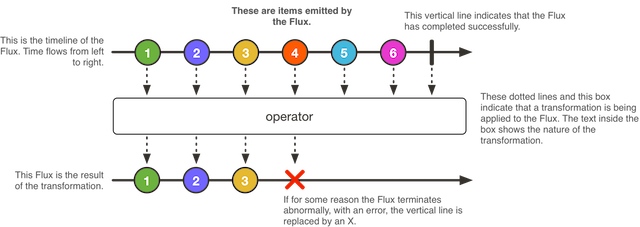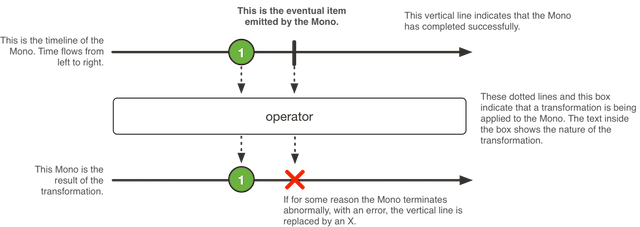Reactor Core
Non-Blocking Reactive Streams Foundation for the JVM both implementing a Reactive Extensions inspired API and efficient event streaming support.
The master branch is now dedicated to development of the 3.3.x line.
Getting it
Reactor 3 requires Java 8 or + to run.
With Gradle from repo.spring.io or Maven Central repositories (stable releases only):
repositories {
maven { url 'https://repo.spring.io/snapshot' }
// maven { url 'https://repo.spring.io/milestone' }
mavenCentral()
}
dependencies {
//compile "io.projectreactor:reactor-core:3.4.1-SNAPSHOT"
//testCompile("io.projectreactor:reactor-test:3.4.1-SNAPSHOT")
//TODO change to the release artifact and comment snapshot repo above when GA
compile "io.projectreactor:reactor-core:3.4.0-SNAPSHOT"
testCompile("io.projectreactor:reactor-test:3.4.0-SNAPSHOT")
}See the reference documentation for more information on getting it (eg. using Maven, or on how to get milestones and snapshots).
Note about Android support: Reactor 3 doesn't officially support nor target Android. However it should work fine with Android SDK 26 (Android O) and above. See the complete note in the reference guide.
Trouble importing the project in IDE?
Since the introduction of Java 9 stubs in order to optimize the performance of debug backtraces, one can sometimes encounter cryptic messages from the build system when importing or re-importing the project in their IDE.
For example:
package StackWalker does not exist: probably building under JDK8 butjava9stubswas not added to sourcescannot find symbol @CallerSensitive: probably building with JDK11+ and importing using JDK8
When encountering these issues, one need to ensure that:
- Gradle JVM matches the JDK used by the IDE for the modules (in IntelliJ,
Modules SettingsJDK). Preferably, 1.8. - The IDE is configured to delegate build to Gradle (in IntelliJ:
Build Tools > Gradle > Runnerand project setting uses that default)
Then rebuild the project and the errors should disappear.
Getting Started
New to Reactive Programming or bored of reading already ? Try the Introduction to Reactor Core hands-on !
If you are familiar with RxJava or if you want to check more detailed introduction, be sure to check https://www.infoq.com/articles/reactor-by-example !
Flux
A Reactive Streams Publisher with basic flow operators.
- Static factories on Flux allow for source generation from arbitrary callbacks types.
- Instance methods allows operational building, materialized on each subscription (Flux#subscribe(), ...) or multicasting operations (such as Flux#publish and Flux#publishNext).
Flux in action :
Flux.fromIterable(getSomeLongList())
.mergeWith(Flux.interval(100))
.doOnNext(serviceA::someObserver)
.map(d -> d * 2)
.take(3)
.onErrorResume(errorHandler::fallback)
.doAfterTerminate(serviceM::incrementTerminate)
.subscribe(System.out::println);Mono
A Reactive Streams Publisher constrained to ZERO or ONE element with appropriate operators.
- Static factories on Mono allow for deterministic zero or one sequence generation from arbitrary callbacks types.
- Instance methods allows operational building, materialized on each Mono#subscribe() or Mono#get() eventually called.
Mono in action :
Mono.fromCallable(System::currentTimeMillis)
.flatMap(time -> Mono.first(serviceA.findRecent(time), serviceB.findRecent(time)))
.timeout(Duration.ofSeconds(3), errorHandler::fallback)
.doOnSuccess(r -> serviceM.incrementSuccess())
.subscribe(System.out::println);Blocking Mono result :
Tuple2<Long, Long> nowAndLater =
Mono.zip(
Mono.just(System.currentTimeMillis()),
Flux.just(1).delay(1).map(i -> System.currentTimeMillis()))
.block();Schedulers
Reactor uses a Scheduler as a contract for arbitrary task execution. It provides some guarantees required by Reactive Streams flows like FIFO execution.
You can use or create efficient schedulers to jump thread on the producing flows (subscribeOn) or receiving flows (publishOn):
Mono.fromCallable( () -> System.currentTimeMillis() )
.repeat()
.publishOn(Schedulers.single())
.log("foo.bar")
.flatMap(time ->
Mono.fromCallable(() -> { Thread.sleep(1000); return time; })
.subscribeOn(Schedulers.parallel())
, 8) //maxConcurrency 8
.subscribe();ParallelFlux
ParallelFlux can starve your CPU's from any sequence whose work can be subdivided in concurrent
tasks. Turn back into a Flux with ParallelFlux#sequential(), an unordered join or
use arbitrary merge strategies via 'groups()'.
Mono.fromCallable( () -> System.currentTimeMillis() )
.repeat()
.parallel(8) //parallelism
.runOn(Schedulers.parallel())
.doOnNext( d -> System.out.println("I'm on thread "+Thread.currentThread()) )
.subscribe()Custom sources : Flux.create and FluxSink, Mono.create and MonoSink
To bridge a Subscriber or Processor into an outside context that is taking care of
producing non concurrently, use Flux#create, Mono#create.
Flux.create(sink -> {
ActionListener al = e -> {
sink.next(textField.getText());
};
// without cancellation support:
button.addActionListener(al);
// with cancellation support:
sink.onCancel(() -> {
button.removeListener(al);
});
},
// Overflow (backpressure) handling, default is BUFFER
FluxSink.OverflowStrategy.LATEST)
.timeout(3)
.doOnComplete(() -> System.out.println("completed!"))
.subscribe(System.out::println)The Backpressure Thing
Most of this cool stuff uses bounded ring buffer implementation under the hood to mitigate signal processing difference between producers and consumers. Now, the operators and processors or any standard reactive stream component working on the sequence will be instructed to flow in when these buffers have free room AND only then. This means that we make sure we both have a deterministic capacity model (bounded buffer) and we never block (request more data on write capacity). Yup, it's not rocket science after all, the boring part is already being worked by us in collaboration with Reactive Streams Commons on going research effort.
What's more in it ?
"Operator Fusion" (flow optimizers), health state observers, helpers to build custom reactive components, bounded queue generator, converters from/to Java 9 Flow, Publisher and Java 8 CompletableFuture. The repository contains a reactor-test project with test features like the StepVerifier.
Reference Guide
https://projectreactor.io/docs/core/release/reference/docs/index.html
Javadoc
https://projectreactor.io/docs/core/release/api/
Getting started with Flux and Mono
https://github.com/reactor/lite-rx-api-hands-on
Reactor By Example
https://www.infoq.com/articles/reactor-by-example
Head-First Spring & Reactor
https://github.com/reactor/head-first-reactive-with-spring-and-reactor/
Beyond Reactor Core
- Everything to jump outside the JVM with the non-blocking drivers from Reactor Netty.
- Reactor Addons provide for adapters and extra operators for Reactor 3.
Powered by Reactive Streams Commons
Licensed under Apache Software License 2.0
Sponsored by Pivotal






